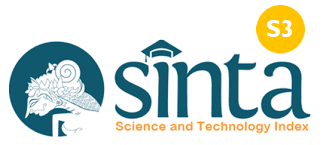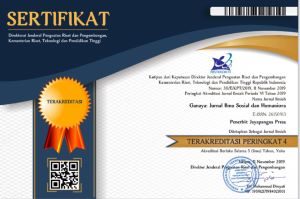Online Learning Course Amid Outbreaks: A Comparison of Satisfaction Between Islamic High School and High School Students
DOI:
https://doi.org/10.37329/cetta.v6i1.2094Keywords:
Online Learning Process, Online Course Satisfaction, Islamic High School and High School, LFH ProblemsAbstract
Amid outbreaks, with limited preparation and infrastructure, learning is carried out by all of school in Indonesia. This research is aimed to investigate the satisfaction of Islamic high school (IHS) and high school (HS) students with online learning that they have participated in during the pandemic. This research is quantitative research. Data was collected by online questionnaire which was distributed to 520 HIS students and 796 HS students in South Kalimantan. Data were analyzed by t-test to determine the significance of differences in satisfaction levels. The results found that online learning during the pandemic was carried out with various platforms, and there were no changes in the learning system: curriculum and syllabus. Online learning in South Kalimantan at the IHS/HS level is faced with problems with an internet connection, internet quota, student independence, learning design, and technical ability. The satisfaction of IHS and HS students in South Kalimantan with regard to learning is in the quite satisfactory category (average score of 2.9). The difference between the two types of education is significant 0.009, with a significance level of <0.05. Thus, H0 is rejected, and Ha is accepted.
References
Agarwal, S., & Kaushik, J. S. (2020). Student’s Perception of Online Learning during COVID Pandemic. The Indian Journal of Pediatrics, 87(7), 554–554.
Agyeiwaah, E., Badu Baiden, F., Gamor, E., & Hsu, F.-C. (2022). Determining the attributes that influence students’ online learning satisfaction during COVID-19 pandemic. Journal of Hospitality, Leisure, Sport & Tourism Education, 30, 100364.
Alghamdi, A. (2021). COVID-19 mandated self-directed distance learning: Experiences of Saudi female postgraduate students. Journal of University Teaching and Learning Practice, 18(3), 213–231.
Altuwairesh, N. (2021). Female Saudi University Students’ Perceptions of Online Education amid COVID-19 Pandemic. Arab World English Journal, 381–397.
Arsdol, M. D. V., & Jahn, J. A. (1952). Time and Population Sampling Applied to the Estimation of Expenditures of University Students. American Sociological Review, 17(6), 738.
Baloran, E. T., Hernan, J. T., & Taoy, J. S. (2021). Course Satisfaction and Student Engagement in Online Learning Amid Covid-19 Pandemic: A Structural Equation Model. Turkish Online Journal of Distance Education, 1–12.
Bayrak, F., Tibi, M. H., & Altun, A. (2020). Development of Online Course Satisfaction Scale. Turkish Online Journal of Distance Education, 21(4), 110–123.
Bervell, B., Umar, I. N., & Kamilin, M. H. (2020). Towards a model for online learning satisfaction (MOLS): Re-considering non-linear relationships among personal innovativeness and modes of online interaction. Open Learning, 35(3), 236–259.
Condon, M., Lavery, L., & Engle, P. J. (2016). Measuring Social Capital: Accounting for Nested Data and Subnetworks Within Schools. Social Indicators Research, 126(3), 1189–1207.
Demuyakor, J. (2021). COVID-19 Pandemic and Higher Education: Leveraging on Digital Technologies and Mobile Applications for Online Learning in Ghana. Shanlax International Journal of Education, 9(3), 26–38.
Dw, D. (2021, August 4). Wawancara BDR. Personal communication.
Emre Avci, Y., Tösten, R., & Sahin, Ç. Ç. (2020). Examining the Relationship between Cultural Capital and Self-Efficacy: A Mixed Design Study on Teachers. Athens Journal of Education, 7(2), 169–192.
Fedor, C. G. (2020). Return to Cultural Capital: Case Study. Social Research Reports, 12, 22–38.
Gajek, K., & Marchlik, P. (2021). Polish low-income mothers: Conversions of human, social and cultural capitals through their lifetime. Contemporary Social Science, 16(4), 494–508.
Koh, J. H. L., & Daniel, B. K. (2022). Shifting online during COVID-19: A systematic review of teaching and learning strategies and their outcomes. International Journal of Educational Technology in Higher Education, 19(1), 1–23.
Kuranchie, A., & Addo, H. (2017). Differential Parental Social Capital Investment in Children’s Education: Research Evidence. African Educational Research Journal, 5(3), 207–214.
Larsen, A., & James, T. (2022). A sense of belonging in Australian higher education: The significance of self-efficacy and the student-educator relationship. Journal of University Teaching & Learning Practice, 19(4), 1–15.
Maqableh, M., & Alia, M. (2021). Evaluation online learning of undergraduate students under lockdown amidst COVID-19 Pandemic: The online learning experience and students’ satisfaction. Children and Youth Services Review, 128, 106160.
Mukhtar, K., Javed, K., Arooj, M., & Sethi, A. (2020). Advantages, Limitations and Recommendations for online learning during COVID-19 pandemic era: Online learning during COVID-19 pandemic era. Pakistan Journal of Medical Sciences, 36.
Pagulayan, E. S., Asuncion, J. E. L., Tamayao, A. I., Vecaldo, R. T., Mamba, M. T., & Paat, F. M. G. (2021). The value of economic and cultural capital to college readiness among Filipino senior high school graduates. International Journal of Evaluation and Research in Education (IJERE), 10(1), 174.
Palese, A., Bortoluzzi, G., Achil, I., Jarosova, D., Notara, V., Vagka, E., Andrascikova, S., Rybarova, L., & Skela‐Savič, B. (2014). Students’ and families’ expenditures to attend a nursing programme in 2011–2012: A comparison of five southern European countries. Journal of Advanced Nursing, 70(2), 323–335.
Rabin, E., Henderikx, M., Kalman, Y. M., & Kalz, M. (2020). What Are the Barriers to Learners’ Satisfaction in MOOCs and What Predicts Them? The Role of Age, Intention, Self-Regulation, Self-Efficacy and Motivation. Australasian Journal of Educational Technology, 36(3), 119–131.
Rafsanjani, M. A., Pamungkas, H. P., Laily, N., & Prabowo, A. E. (2021). Online Learning During the Covid-19 Pandemic: Readiness and Satisfaction among Indonesian Students. Center for Educational Policy Studies Journal.
Ratham, C. (2022). Thai University Students’ Perceptions of Online Education after Extended Period of Emergency Remote Education. International Journal of Progressive Education, 18(5), 64–79.
Richard S. Lazarus. (1999). Hope: An Emotion and a Vital Coping Resource Against Despair. Social Research, 66(2), 653.
Robins JR, L. (2021). Investigating Critical Thinking Disposition, Self-Efficacy, Self-Regulation, and Self-Identity Amongst Online Students. College Student Journal, 55(3), 325–337.
Schrenk, N., Alves, K., Van Dam, D., & Schrenk, B. (2021). Reflecting on Best Practices for Online Learning in a Post-COVID-19 World. Online Learning, 25(4), 486–504.
Shen, D., Cho, M.-H., Tsai, C.-L., & Marra, R. (2013). Unpacking online learning experiences: Online learning self-efficacy and learning satisfaction. The Internet and Higher Education, 19, 10–17.
Sunaryo, W., & Sri, S. (2021). Optimizing Transformational Leadership Strengthening, Self Efficacy, and Job Satisfaction to Increase Teacher Commitment. International Journal of Instruction, 14(4), 427–438.
Suparjan Suparjan & Mariyadi Mariyadi. (2021). The motives using google classroom as a distance learning media during the covid-19 pandemic at the elementary school level in pontianak. Premiere Educandum, 11(2).
Thanasi-Boçe, M. (2021). The Role of the Instructor, Motivation, and Interaction in Building Online Learning Satisfaction during the Covid-19 Pandemic. Electronic Journal of E-Learning, 19(5), 401–415.
Tian, M., & Lu, G. (2022). Online learning satisfaction and its associated factors among international students in China. Frontiers in Psychology, 13, 916449.
Topor, A., Skogens, L., & von Greiff, N. (2018). Building trust and recovery capital: The professionals’ helpful practice. Advances in Dual Diagnosis, 11(2), 76–87.
Tschannen-Moran, M. (2014). Trust matters: Leadership for successful schools (Second edition). Jossey-Bass.
Tschannen-Moran, M., & Gareis, C. (2015). Principals, Trust, and Cultivating Vibrant Schools. Societies, 5(2), 256–276.
Wei, H.-C., & Chou, C. (2020). Online learning performance and satisfaction: Do perceptions and readiness matter? Distance Education, 41(1), 48–69.
Weiqin Zhou, Long Zhao, & Mohammed Kaabar. (2022). The Effect of Teachers’ Support on Learners’ Online Self-Regulated Learning: Mediating Analysis Based on Self-Efficacy. International Journal of Emerging Technologies in Learning, 17(17), 207–217. Education Research Complete.
Xhelili, P., Ibrahimi, E., Rruci, E., & Sheme, K. (2021). Adaptation and perception of online learning during COVID-19 pandemic by Albanian university students. International Journal on Studies in Education, 3(2), 103–111.
Yuanyuan He & Xin Fu. (2022). Learning Satisfaction of Learners and Curriculum Design Under Different Online Teaching Platforms. International Journal of Emerging Technologies in Learning, 17(10), 227–239.
Downloads
Published
How to Cite
Issue
Section
License
Copyright (c) 2023 Ahmad Juhaidi, Noor Hidayati, Hamdani, Maulida Rezkia, Ahmad Wafa Nizami

This work is licensed under a Creative Commons Attribution-ShareAlike 4.0 International License.
An author who publishes in the Cetta : Jurnal Ilmu Pendidikan agrees to the following terms:
- Author retains the copyright and grants the journal the right of first publication of the work simultaneously licensed under the Creative Commons Attribution-ShareAlike 4.0 License that allows others to share the work with an acknowledgement of the work's authorship and initial publication in this journal
- Author is able to enter into separate, additional contractual arrangements for the non-exclusive distribution of the journal's published version of the work (e.g., post it to an institutional repository or publish it in a book) with the acknowledgement of its initial publication in this journal.
- Author is permitted and encouraged to post his/her work online (e.g., in institutional repositories or on their website) prior to and during the submission process, as it can lead to productive exchanges, as well as earlier and greater citation of the published work (See The Effect of Open Access).
Read more about the Creative Commons Attribution-ShareAlike 4.0 Licence here: https://creativecommons.org/licenses/by-sa/4.0/.





